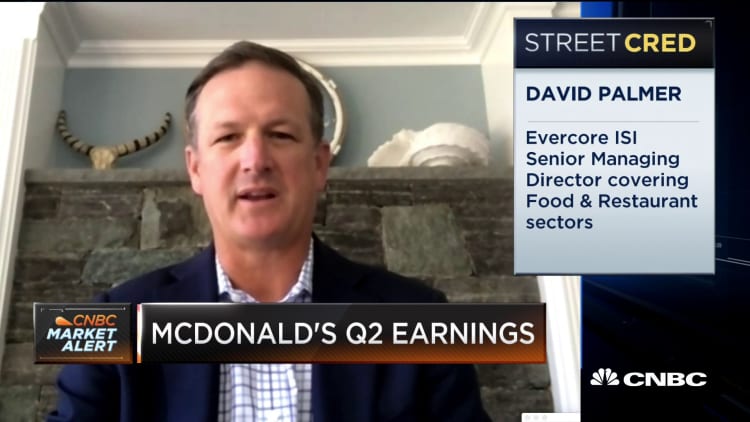McDonald's is seeing some consumer behavior trends reverse as lockdowns ease, but the fast-food giant thinks higher delivery orders and other buying patterns will stick around long after the coronavirus pandemic.
The company reported its second-quarter results on Tuesday. Shares in McDonald's fell 2.1% in morning trading after it said revenue dropped 30% during the three months ended June 30. The stock ended the day down 2.5%.
McDonald's executives said that its average order was larger, but overall customer counts fell during the quarter. As traffic levels improve, order size is decreasing.
"Part of it was due to mix, so you saw delivery becoming a much more pronounced part of the mix during Q2," CEO Chris Kempczinski told analysts.
In Australia, delivery accounted for almost 10% of orders, doubling its prior contribution to sales mix. Delivery in the U.S. hasn't reached those heights yet, although it did grow during the quarter.
"In terms of enduring behavior, I think whether it's the use of kiosks, the use of mobile, the use of delivery, the use of drive-thru, certainly one of the things is that customers are looking for more of a contactless type of experience," Kempczinski said. "They're looking for more of a digital type of experience, one that they can navigate on their own."
Besides more delivery and digital orders, consumers were also using the drive-thru more than usual. In the U.S., nearly 90% of sales came from its drive-thru lanes. CFO Kevin Ozan said that markets with a higher percentage of drive-thru lanes were recovering faster.
But locations near malls, city centers or travel destinations are under more pressure as tourism, indoor shopping and working from office buildings fall out of favor with consumers. Weekend sales have lagged pre-pandemic levels, but weekday business has been faster to recover.
In the U.S., breakfast remains the most challenged time of day. Consumers are making their early morning meals, opting for cereal and frozen waffles over a trip to McDonald's drive-thru. Still, executives said that the chain grew market share during the quarter, which could mean some new customers will keep buying their Egg McMuffins even after they resume their prior routines.
The economy also plays a role in consumer behavior, and McDonald's is looking to use value deals and affordability to get an edge over the competition.
"As you go into potentially a more recessionary type of environment in a number of major markets, having good affordability and making sure that that is a key component of your marketing mix is really important," Kempczinski said.
He said that the expiration of higher unemployment benefits would likely have a negative impact on McDonald's business. Senate Republicans have proposed slashing the extra aid from $600 a week to $200 a week. Kempczinski said that he couldn't predict what the impact of that plan would be on sales.



